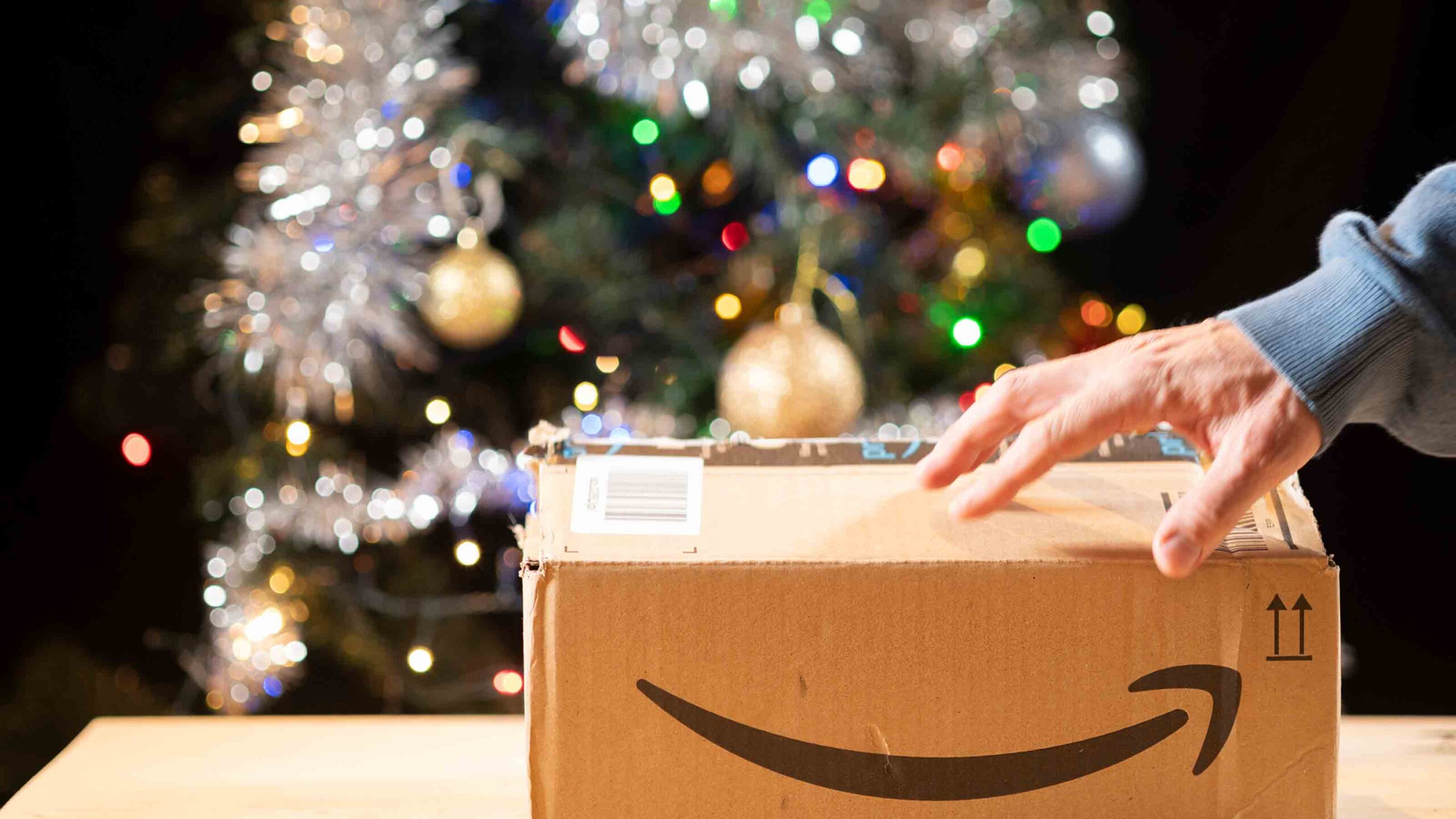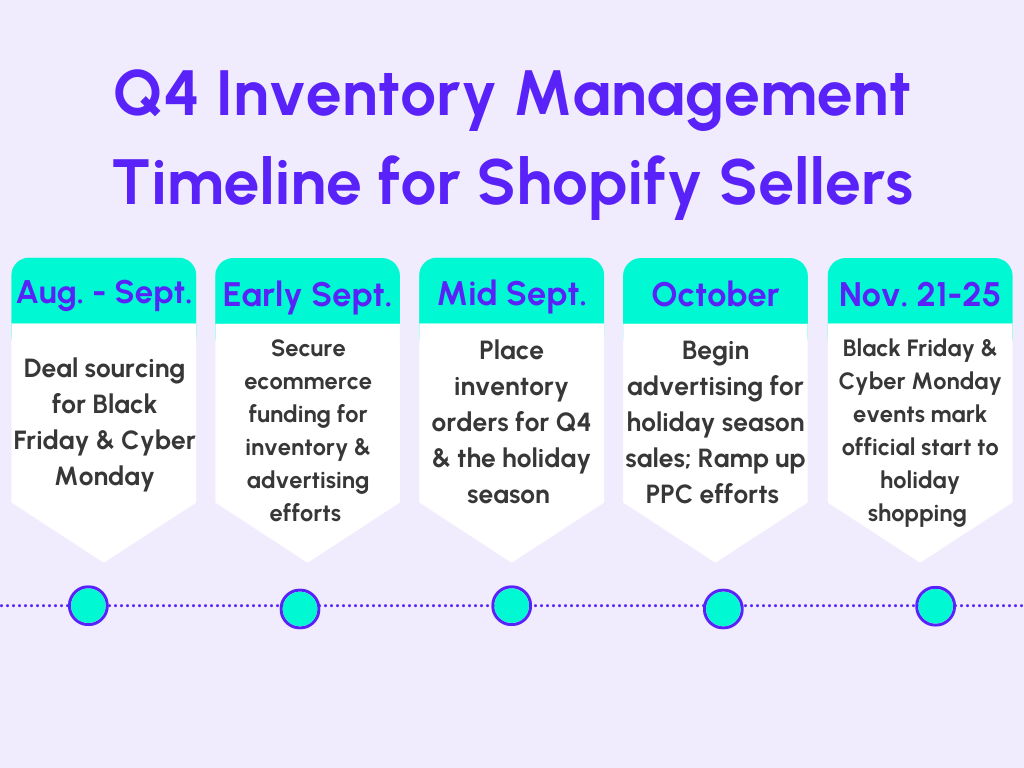As summer winds down and back-to-school season kicks off, it’s time for Shopify business owners to start gearing up for Q4. This holiday season is a golden opportunity to boost your sales and elevate your business, but it can also be a make-or-break moment. With the surge in traffic and potential for big revenue growth during the retail holidays, now is the perfect time to fine-tune your inventory management strategy. With increased sales traffic and the potential for significant revenue growth, Q4 is the perfect chance to seize every sales opportunity and take your business to the next level. However, maximizing those opportunities requires meticulous planning, especially when it comes to inventory management.
In this comprehensive guide, we’ll dive deep into essential Q4 inventory management practices designed to help your Shopify store thrive. From optimizing stock levels to refining your inventory forecasts, harnessing the best technology for success, and coordinating with suppliers, these best practices will help you navigate the busiest shopping season of the year and drive long-term results for your Shopify business. Are you ready? Let’s get stocked!
eCommerce inventory management is the systematic approach to sourcing, storing, and selling stock for your online business. Inventory management processes are designed to help you understand how much stock you have, where and how to store it, how long you’re storing it for, and more. Effective inventory management can help your eCommerce business save on associated costs, prevent waste, and improve your Shopify account health.
While inventory management is important to eCommerce businesses at any point throughout the year, it’s especially imperative between October and January. As the holiday season ramps up consumers are expecting your business to have orders ready almost immediately–expectations that can be challenging to meet as a small business. By introducing effective inventory management strategies ahead of Q4, you’ll provide the scaffolding so that your Shopify business can take full advantage of the shopping season and is fully prepared for whatever challenges may arise, including:
Not only is customer demand typically at a yearly high around Q4, customer purchase intent is also incredibly high close to the holiday season. Holiday sales create a sense of urgency, with limited time deals to catch the eyes of consumers and an abundance of good deals available. This leads to higher conversion rates compared to other points throughout the year, making it imperative that you have the inventory to satisfy increased traffic and demand. Nothing is more frustrating than missing out on a sale because the product is unavailable–especially when a customer was prepared to make a purchase.
If your Shopify website is seeing an increase in traffic around Q4, it will likely be a sign that increased sales are also coming. Efficient inventory management will ensure that you have the inventory to take advantage of this increased buyer-readiness, converting window-shoppers to customers.
Many warehouses and fulfillment centers will raise fees, or introduce a “Peak Season Fee,” throughout Q4 in order to cover the increased cost of fulfillment and transportation during the busy shipping period that comes with the holiday season. By being proactive about inventory management for your Shopify store, you can ensure that inventory is strategically distributed between all warehouses or fulfillment centers so that you never have to rely on safety stock, and can maximize efficiency while minimizing fees.
Accurate demand forecasting paired with smart inventory management will ultimately mean a shorter cash conversion cycle for your Shopify business. With less capital trapped in inventory you can continuously replenish stock, make agile financial decisions based on an updated view of supply chains, and invest in bigger and better holiday advertisement campaigns.
Predictable cash flow is also a hallmark of a healthy eCommerce business. The more consistent your cash flow, the easier you’ll be able to sleep at night knowing that your Shopify business won’t be unexpectedly going into a negative month. And, with more knowledgeable investments, you’ll likely see higher margins and more capital to invest in future growth.
The holiday season is the perfect time of year to increase brand awareness and solidify a positive reputation with consumers. In order to secure your Shopify store’s spot as a fan-favorite though, it’s critical that you provide a great customer experience throughout the entire ordering process.
This goes beyond just providing a seamless shopping experience, customer retention also depends on Shopify sellers ensuring product availability, quick delivery, and accurate order fulfillment–all cornerstones of strategic Q4 inventory management for Shopify stores. Not only will this help you to secure every sale throughout the holiday season, it also has the potential to help you create repeat customers in the long run.
In order to reap the benefits of Q4’s many holiday sales, you’ll have to secure your spot on the nice list by guaranteeing that inventory is always easily available for purchase. By embracing these proven strategies for Q4 inventory management for Shopify now, you’ll establish your brand as convenient and reliable–meaning that you will secure every sale and be trusted to deliver presents on time all season long.
In a perfect world, your Shopify business would always have enough inventory on hand to fulfill orders on time and avoid the lost sales that come as a result of stockouts. However, we all know that it’s not that simple. The holiday season brings a number of challenges for inventory management, including supply chain disruptions, extended lead times on order deliveries, and bottlenecks with fulfillment. That makes it all the more important that you plan ahead to ensure stock levels stay well optimized throughout the entire quarter.
By keeping the ideal amount of product in stock for your Shopify business, you will also avoid the unnecessary storage costs, that we mentioned earlier, and avoid having capital tied up in excess inventory. This is especially crucial during the competitive holiday season, when Shopify stores need to go heavier on promos, discounts, and advertising to compete with eCommerce giants.
To optimize your stock levels, start by categorizing your inventory into different tiers based on their sales performance. Your top-tier products, or bestsellers, should receive the highest priority when it comes to inventory allocation. These are the items that will drive the bulk of your sales during Q4, so ensure you have ample stock to meet demand. For mid-tier products, aim for a balanced approach—stock enough to meet expected demand, but avoid overcommitting resources. Finally, for low-performing products, consider reducing your stock levels or discontinuing them altogether. This will free up valuable warehouse space and capital that can be invested elsewhere.
Enhancing Shopify inventory forecasting goes beyond just reviewing past sales and integrates insights from current market trends and consumer behavior. Economic indicators and retail forecasts provide a broader view of potential shifts in the market.
Historical data
The foundation of effective inventory management for any business lies in accurate demand forecasting. To start, consider analyzing sales data from your Shopify business in the months leading up to Q4, as well as previous holiday seasons. Look for trends in customer behavior, product performance, and seasonal spikes. Identifying which products typically perform the best during the holiday season will help you make data-driven decisions.
Current Market Trends
In addition to historical data, consider external factors that could influence demand this year. Are there any changes in consumer trends or behaviors? Is the economic environment different from previous years? Have there been significant changes in your target market? Combining historical data with insights from current market conditions will help you create a more accurate and agile forecast for inventory.
Watch Marketplace Giants
Finally, keeping an eye on industry leaders like Amazon and Walmart can also provide valuable insights into broader market trends. These eCommerce marketplace giants have extensive resources to analyze market conditions and adjust their strategies accordingly, compared to your individual Shopify store. For example, if you notice that Amazon is ramping up its inventory of certain products, it could be an indication of expected high demand in that category. Monitoring these trends can help you stay ahead of the curve and prepare your Shopify business with a better understanding of consumer desires.

In the constantly evolving landscape of eCommerce, it’s never been more important to leverage the right tools and technology if you want to keep up with market standards. And, it’s of the utmost importance in Q4 when the competition for sales is, arguably, at its highest for Shopify business owners. This means that investing in a strong Q4 inventory management system (IMS) for your Shopify business is imperative.
Inventory management systems use technology to centralize, streamline, and visualize the flow of inventory in your Shopify business. While Shopify offers inventory management for Shopify stores on-platform, many entrepreneurs opt to use third party technology that can scale with their business and its needs. The best IMS tools help to ensure that the right quantities of inventory are always in-stock by:
Inventory management systems can be updated periodically or perpetually, so make sure that you choose a system that works well for your Shopify business.
Establishing and maintaining strong relationships with your suppliers is more important than ever during the Q4 rush. While you should engage with suppliers for your Shopify store periodically throughout the year to make orders and do quality assurance checks, positive interactions (or lack thereof) with your suppliers can make or break your Q4 inventory management. Discuss inventory needs, buffer stock, and predicted lead times with your suppliers ahead to time to guarantee clear communication and expectations for everyone.
Engaging with suppliers early on will allow you to negotiate better terms on lead times and pricing, as well as provide your suppliers with better demand forecasting data, increased cash flow, and healthy timelines. By relying on healthy supplier relationships and strategically ordering ahead, you can ensure that inventory needs are met promptly and efficiently for your Shopify business. It will also help with timing your inventory replenishments correctly to make sure that you have enough stock to meet demand without over committing resources.
Many Shopify stores operate within businesses that extend beyond their individual website. If you’re operating on multiple fronts, whether on other eCommerce marketplaces (like Amazon or Walmart) or brick-and-mortar stores, coordinating inventory effectively is critical. Segmenting inventory to ensure adequate stock across all channels prevents overstocking issues and can help guarantee product availability. By strategically coordinating across multiple channels you can also align inventory with overarching sales and logistical strategies.
Synchronizing Q4 inventory management for Shopify businesses with marketing efforts is crucial, especially for products highlighted in major holiday sales promotions like Black Friday and Cyber Monday. Promoting a product that’s already in short supply can lead to stockouts and disappointed customers. Before launching any promotional campaigns, make sure you have enough stock to meet the expected demand.
Ensuring that high-demand SKUs are always available to avoid stock outs during peak promotional periods is vital for capturing all potential sales and enhancing customer satisfaction.
Efficient logistics and fulfillment from Shopify sellers is critical to delivering a great customer experience during Q4. With increased order volumes and tight shipping deadlines, it’s essential to streamline your fulfillment processes to ensure timely deliveries. To make this possible, consider:
For many Shopify business owners, outsourcing fulfillment to a third-party logistics (3PL) provider is a smart move during the holiday season. 3PL providers can handle the warehousing, packing, and shipping of your products, allowing you to focus on other aspects of your business. They often have the capacity to scale with your needs during peak seasons, which can help you manage increased order volumes more efficiently.
Shipping costs and delivery times are major considerations for customers during the holiday season. To stay competitive, consider offering free shipping or discounted rates on orders over a certain amount. You can also optimize your shipping strategy by working with multiple carriers and choosing the most cost-effective options based on your customers’ locations.
In addition, make sure to communicate clearly with your customers about shipping deadlines for holiday delivery. Set realistic expectations to avoid any potential issues with delayed deliveries.
Automating your fulfillment processes can save time and reduce errors during Q4. Shopify offers a range of automation tools that can streamline order processing, label printing, and shipping notifications. By automating repetitive tasks, you can free up time to focus on higher-level strategy and customer service.
Now that we’ve laid out the importance of Q4 inventory management for Shopify businesses, as well as some strategies to secure success, it’s time to review common associated mistakes. By taking these potential challenges into account now, you can proactively plan for your Shopify business and make sure that they don’t slow down sales throughout your Q4.
Did you know that around 67% of supply chain managers still report using Excel to manage their inventory? This leaves room for a significant margin of error that could potentially cost your Shopify business during the busiest sales season of the year. As mentioned previously, failing to accurately forecast inventory demand can lead to both stockouts and excess inventory, which can have a negative impact on your profitability.
In order to improve your inventory forecasting, consider the following:
While spreadsheets can be useful in managing inventory when your Shopify business first starts, they aren’t sustainable long-term. Unfortunately inventory spreadsheets are prone to human error, which can end up significantly costing your business. At the same time, spreadsheets typically require manual maintenance which takes time and energy that could be better focused on other aspects of Q4 inventory management for your Shopify store.
To avoid costly spreadsheet errors:
Without real-time visibility into your inventory, it becomes virtually impossible to scale your business, especially during busy seasons. Without the ability to make informed decisions regarding your stock levels and reordering needs, you could find yourself overstocked on a product in one channel and completely out of stock in another. Inevitably this will lead to lost customers, who increasingly expect retailers to know exactly what they have in stock.
To get greater visibility into your inventory:
 Even the most robust Q4 inventory management for Shopify businesses can be rendered useless if your shipping and fulfillment processes are inefficient. Incorrect orders, damaged items, and late shipment arrivals can all lead to customer returns that can be damaging your profit margins. Not to mention that inefficient order fulfillment processes can make your brand look bad, damaging your reputation and customer loyalty over time.
Even the most robust Q4 inventory management for Shopify businesses can be rendered useless if your shipping and fulfillment processes are inefficient. Incorrect orders, damaged items, and late shipment arrivals can all lead to customer returns that can be damaging your profit margins. Not to mention that inefficient order fulfillment processes can make your brand look bad, damaging your reputation and customer loyalty over time.
To improve your fulfillment and satisfy customers every time, consider:
By mapping out key dates and critical action periods in Q4 for your Shopify store’s inventory management, you’ll establish a strong plan to maximize holiday sales. In order to solidify success, make sure that you’re keeping the following timeline in mind:

By securing additional funds for your Shopify business in advance, you can ensure the financial agility and liquidity to take advantage of every opportunity that presents itself. Whether you’re stocking up on inventory in advance, upgrading advertisement campaigns, or adjusting fulfillment strategies, supplemental working capital will provide your Shopify business with the cushion to act confidently. Not only can eCommerce funding provide you with the resources to grow your business throughout Q4 though, it can also help ensure that your cash flow remains strong in the months following.
With a strategic approach and careful inventory management planning, you’ll be well-prepared to crush Q4 and make the most of the holiday shopping season. However, if you’re looking to truly maximize sales and success, you’ll need to make quite the investment. The sooner you can take advantage of eCommerce funding, the more you can negotiate better rates for your Shopify business, implement new tools and technologies ahead of the busy holiday season, and keep inventory levels consistent throughout the entire quarter. That’s why Viably is here to help.
Viably is a people-first banking and funding experience, designed to help Shopify store owners grow their business to the best of their ability–in the ways that they know how. With tailor-made funding offers, you have the working capital you need to invest in maximizing holiday sales for your Shopify businesses in your bank account as soon as tomorrow.
Viably Capital Inc. is a financial technology company, not a bank. Some Viably Banking® services are provided by Piermont Bank, Member FDIC.* Viably Payments® services for U.S. customers are provided through Airwallex US, LLC (NMLS #1928093). Airwallex is licensed or authorized to do business as a money transmitter in most states. For some U.S. customers, Airwallex partners with Evolve Bank & Trust (member FDIC) to provide payments services. The Viably Mastercard® debit card is issued by Piermont Bank pursuant to a license by Mastercard International Incorporated and may be used anywhere Mastercard debit cards are accepted. The Viably Visa® debit card is issued by CFSB and may be used anywhere Visa debit cards are accepted. Applications for Viably Banking® and Viably Payments® services are subject to approval. Terms and Conditions for Viably Banking® and Viably Payments® services apply and are subject to change. No application or monthly fee. Some fees and limits may apply.
Viably Growth Capital and Viably Cash Advance products are offered solely through Viably and are not part of the Viably Banking® or Viably Payments® Services provided by Piermont Bank and Airwallex, respectively.
* The funds in your account held at Piermont Bank are FDIC insured up to $250,000 per depositor for each ownership category.
©2024 VIABLY. All rights reserved. Viably®, Viably Banking® and Viably Payments® are registered trademarks of Viably Capital, Inc.